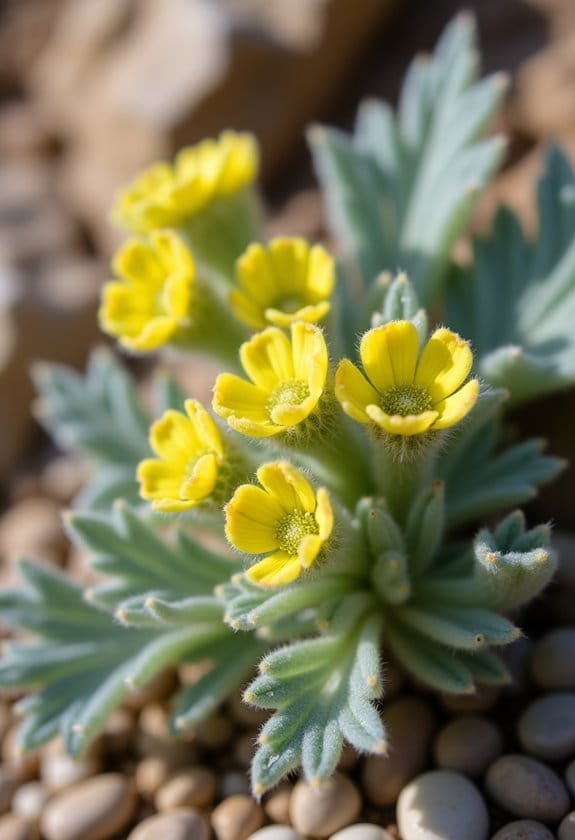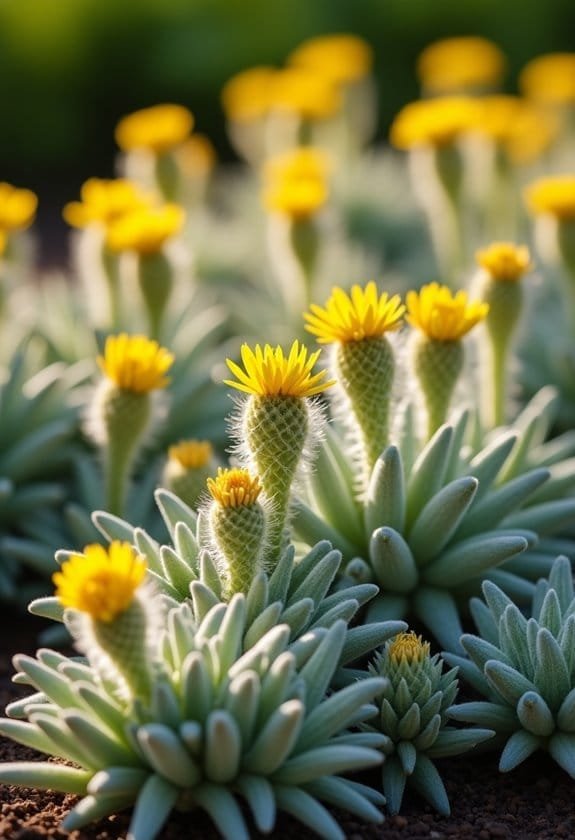Kidney Vetch (Anthyllis vulneraria) is a hardy perennial wildflower that's vital to European grassland ecosystems. It grows 5-40 centimeters tall, forming cushion-like clusters adorned with vibrant yellow flower heads from June through September. The plant's distinctive silky leaflets and drought-tolerant nature make it ideal for chalk grasslands and coastal dunes, where it plays a pivotal role in soil stabilization. As a member of the Fabaceae family, it enriches soil through nitrogen fixation while supporting diverse pollinator populations, particularly bumblebees and solitary bees. Its historical significance as "woundwort" hints at fascinating traditional uses waiting to be explored.
Main Points
- Kidney Vetch is a perennial wildflower with yellow flower clusters, growing 5-40cm tall in coastal regions and grasslands across Europe.
- The plant flowers from June to September, providing essential nectar for bumblebees and solitary bees.
- A member of the Fabaceae family, it fixes nitrogen in soil and stabilizes sandy or chalky ground with its extensive roots.
- Thrives in well-drained soils and full sun, requiring minimal maintenance while being drought-tolerant and hardy to -10°F.
- Historically known as "woundwort," it faces conservation challenges due to urban expansion but supports biodiversity in grassland ecosystems.
Introduction

Kidney Vetch (Anthyllis vulneraria) stands as a resilient perennial wildflower that graces the coastal regions and grasslands throughout the United Kingdom and Europe.
This hardy plant, reaching heights of up to 30 centimeters, features distinctive yellow flower clusters and silky, divided leaves that form dense, cushion-like growths on bare soil.
Known traditionally as "woundwort," Kidney Vetch has earned its place in both ecological systems and historical medicine, serving as a crucial component of local biodiversity while historically being used to treat various ailments.
Common Name
The vibrant wildflower known as Kidney Vetch (Anthyllis vulneraria) displays distinctive clusters of yellow, orange, or red blooms during its summer flowering period from June to September. This hardy perennial, reaching heights of up to 30 centimeters, has earned its primary common name through its historical applications in traditional medicine.
The plant's alternative name, "woundwort," reflects its significant role in historical healing practices, particularly in treating swelling and promoting wound recovery.
Though not commonly found in North America, Kidney Vetch has established itself as a remarkable presence across diverse British landscapes, from coastal regions to chalk grasslands and sand dunes.
As a member of the extensive Fabaceae family, this resilient herb contributes to ecosystem health through its natural nitrogen-fixing abilities.
The plant's distinctive rounded flower clusters serve as nature's jewels, adorning the summer landscape with their vibrant hues. These characteristic blooms not only make the plant easily identifiable but also highlight its importance in supporting local biodiversity, particularly in grassland ecosystems where it thrives as a fundamental component of the natural habitat.
Scientific Name
Botanist Carl Linnaeus first described and classified Anthyllis vulneraria in his seminal work "Species Plantarum" in 1753, establishing the scientific nomenclature that's still used today. This taxonomy classification places the plant within the extensive Fabaceae family, which encompasses numerous leguminous plants of ecological significance.
The scientific name reflects both the genus Anthyllis and the specific epithet vulneraria, with the latter derived from the Latin word "vulnus," meaning wound, alluding to its historical uses in traditional medicine.
The plant's remarkable diversity is evident in its numerous subspecies, some of which taxonomists have elevated to separate species status due to their distinct morphological characteristics. These variations are particularly noticeable in the flower heads, which can range from the typical yellow to striking red hues in certain subspecies.
The plant's physical attributes are well-defined within its scientific classification, featuring compound leaves with 5-15 leaflets and a height range of 5 to 40 centimeters, characteristics that help botanists distinguish it from related species within the Fabaceae family.
Overview
Widely recognized for its distinctive yellow flower clusters and medicinal properties, Anthyllis vulneraria, commonly known as Kidney Vetch, is a hardy perennial plant that's become a cornerstone species in many European grasslands.
This remarkable member of the Fabaceae family demonstrates significant ecological importance through its ability to thrive in diverse habitats, from coastal dunes to chalk-rich soils.
Standing at a modest height of 30cm, Kidney Vetch's historical uses are deeply rooted in traditional medicine, where it earned the name "woundwort" for its remarkable healing properties.
Its cultural significance extends beyond its therapeutic applications, as the plant has become an integral part of Britain's natural heritage.
The plant's distinctive features include silky leaflets with white undersides and compact flower heads that burst into vibrant displays of yellow, orange, or red blooms from June through September.
These flowering periods are essential for local biodiversity, providing crucial sustenance for numerous pollinating insects.
The plant's adaptability to well-drained, sandy soils has enabled it to establish itself as an important component of various ecosystems, particularly in coastal regions throughout the United Kingdom.
Key Features
Kidney Vetch stands out with its compact stature, reaching heights between 5 and 40 centimeters, and showcases distinctive clusters of mainly yellow flowers that occasionally display orange or red variations.
The plant's leaves exhibit a silvery, woolly appearance due to their silky leaflets and white undersides, while its flowers are encased in a hairy calyx that adds to its soft texture.
This remarkable wildflower graces British landscapes from June through September, creating vibrant displays across coastal regions and chalk grasslands where it has adapted to thrive in well-drained, sandy soils.
Growth Size
This hardy perennial herb typically reaches heights between 5 to 40 centimeters (2.0 to 15.7 inches), forming cushion-like clusters that spread up to 12 inches wide. Its compact growth habits make it particularly well-suited as a ground cover, efficiently colonizing bare soil areas while maintaining a neat, controlled appearance throughout its growing season.
The plant's moderate size and spreading nature reflect its habitat preferences, allowing it to thrive in various environments without overwhelming neighboring species.
During its peak flowering period from June to September, the plant's structure becomes more pronounced as it produces dense clusters of yellow blooms atop its woolly stems. The arrangement of 5-15 narrow, silky leaflets contributes to the plant's overall dimensional characteristics, creating a layered effect that enhances its visual appeal while maintaining its modest stature.
These growth patterns make Kidney Vetch an ideal choice for propagation methods focused on ground coverage and soil stabilization, as its spreading habit remains manageable while effectively fulfilling its ecological role in various landscape applications.
Appearance
Naturally adapted to its environment, Anthyllis vulneraria displays distinctive features that set it apart from similar species. The plant's most striking characteristic is its compact clusters of mainly yellow flowers, which occasionally exhibit stunning orange or red color variations, all nestled within a protective woolly calyx.
The leaf structure analysis reveals a complex arrangement of narrow, silky leaflets that create an aesthetically pleasing contrast with their distinctive white undersides. These leaves demonstrate remarkable adaptation to various habitat preferences, allowing the plant to thrive in diverse conditions while maintaining its cushion-like growth pattern.
The plant's overall appearance reflects its successful evolutionary strategy, with flowers blooming prominently from June through September.
While often mistaken for Lotus corniculatus, Kidney Vetch maintains several unique morphological traits that aid in proper identification. Its woolly flower heads and characteristic leaf structure serve as reliable distinguishing features, while its compact growth habit, ranging from 5 to 40 centimeters in height, creates an unmistakable visual signature in its natural habitat.
Flowering Season
During the warmer months of June through September, Anthyllis vulneraria reaches its peak display with vibrant clusters of yellow flowers. These distinctive blooms, measuring 10-20 mm in diameter, emerge in rounded formations that transform the plant's appearance during its prime flowering period.
The flowering patterns of kidney vetch align perfectly with the peak activity of significant pollinators, particularly bumblebees, which are drawn to its nectar-rich blossoms. As seasonal variations progress through summer, the plant achieves its maximum height of 30 centimeters while forming dense, cushion-like growths across bare soil patches.
The pollination timing coincides with ideal conditions for seed development and dispersal.
What makes this flowering period particularly striking is the combination of the plant's woolly-textured flower heads and its distinctive foliage. The silky leaflets, with their contrasting white undersides, create an eye-catching display against the yellow, orange, or occasionally red blooms.
This remarkable seasonal transformation not only enhances the aesthetic value of natural landscapes but also provides essential support for local ecosystem biodiversity throughout the summer months.
Growing Requirements

Kidney Vetch thrives in well-draining soils and adapts remarkably well to both clay-based and drought-prone environments, making it a versatile choice for various garden conditions.
The plant's resilience is demonstrated through its impressive temperature tolerance down to -10°F, while its modest water requirements and preference for full sun to partial shade conditions make it particularly low-maintenance.
Growing to a maximum height of 30 cm, this hardy perennial forms dense, cushion-like formations that serve as effective ground cover, requiring minimal intervention beyond occasional aesthetic pruning.
Light
A vital component of Kidney Vetch's successful growth lies in its exposure to sunlight. This resilient plant demonstrates a marked preference for abundant light conditions, thriving particularly well in locations that receive full sun throughout the day.
While it can tolerate partial shade, ideal growth and flowering occur under direct sunlight exposure.
The plant's light requirements align perfectly with its natural habitat preferences, where it's commonly found in open, exposed areas such as rocky slopes and coastal regions.
In garden settings, positioning Kidney Vetch in unobstructed locations guarantees it receives the maximum sunlight necessary for robust development.
The relationship between its light requirements and drought tolerance creates ideal conditions for the plant's survival, as sunny locations often correlate with well-draining soils and drier environments.
When cultivating Kidney Vetch in managed landscapes, gardeners should prioritize locations that receive at least six hours of direct sunlight daily, though the plant will flourish with even more exposure.
This sun-loving nature, combined with its cold hardiness to -10°F, makes it an exceptionally versatile choice for various garden designs.
Soil
While many plants demand specific soil conditions, Kidney Vetch demonstrates remarkable adaptability across various soil types. This resilient herb particularly excels in well-draining soils, showing a notable preference for sandy and calcareous substrates that mirror its natural habitat in dry grasslands and rocky terrain.
The plant's versatility extends to its ability to establish itself in various soil compositions, including clay-based environments, though proper drainage remains essential for its success. Its extensive root system enables survival at impressive altitudes of up to 3,000 meters, where soil conditions can vary considerably.
One of Kidney Vetch's most valuable characteristics is its nitrogen fixation capability, which enhances soil fertility in its surrounding environment. This natural process transforms the plant into a beneficial contributor to grassland ecosystems, improving soil quality for neighboring vegetation.
When it comes to moisture requirements, the plant's drought-tolerant nature means it thrives with intermittent watering, making it an excellent choice for areas where consistent irrigation isn't guaranteed or practical.
Water
For ideal growth, Kidney Vetch requires minimal watering due to its natural drought tolerance and adaptable nature. This resilient plant employs efficient water conservation strategies, making it particularly suitable for gardens emphasizing sustainable irrigation techniques.
Once established, it demonstrates remarkable adaptability to varying moisture conditions, thriving with intermittent watering schedules. Implementing effective drought management practices is essential for maintaining healthy Kidney Vetch specimens, especially during their initial growth phase.
The plant's ability to withstand temperatures as low as -10º F complements its water-efficient characteristics, creating a remarkably hardy species. When planning irrigation techniques, gardeners should focus on consistent moisture monitoring, particularly during extended dry periods, while being careful to avoid oversaturation.
Well-draining soil plays a significant role in the plant's water requirements, as it prevents root rot and other moisture-related issues. The plant's preference for sunny or partially shaded locations further enhances its natural water retention capabilities, allowing it to maintain prime hydration levels with minimal intervention.
This balance of environmental factors and careful water management guarantees the plant's long-term health and success.
Temperature
Temperature management enhances Kidney Vetch's natural resilience, complementing its efficient water usage patterns. The plant's remarkable temperature adaptation enables it to withstand frigid conditions, surviving in environments where temperatures plummet to an impressive -10º Fahrenheit, making it a hardy choice for temperate regions.
This robust perennial demonstrates exceptional temperature resilience throughout the seasons, thriving in both full sun exposure and partially shaded locations where temperature fluctuations are less extreme. Its ability to navigate temperature extremes while maintaining healthy growth patterns reflects the species' evolutionary adaptability to diverse climatic conditions.
The plant's compact growth habit, reaching only 8 inches in height, contributes to its temperature management strategy by staying close to the ground where microclimate conditions are often more stable. When cultivated in well-draining soils, whether clay or sandy, Kidney Vetch maintains its temperature tolerance capabilities while establishing strong root systems that support its survival through challenging weather patterns.
This combination of characteristics positions Kidney Vetch as an excellent choice for gardens in regions experiencing significant seasonal temperature variations.
Pollinator Criteria
Kidney Vetch serves as an important nectar source for diverse pollinator species, with its yellow flower clusters attracting an array of bumblebees, solitary bees, and other beneficial insects.
The plant's extended flowering period from June through September establishes it as a reliable food source during significant months when pollinators are most active.
Its distinctive cushion-like growth pattern not only provides accessible landing platforms for feeding visitors but also offers protective shelter for ground-nesting pollinators, making it an essential component of healthy grassland ecosystems.
Attracted Pollinators
Throughout its flowering season from June to September, the bright yellow clusters of Kidney Vetch serve as an important food source for numerous pollinators, especially bumblebees.
These compact, cushion-like flower formations create ideal foraging conditions that support significant pollinator diversity within grassland ecosystems.
The plant's specialized flower structure has evolved to maximize pollinator attraction, with its vibrant yellow blooms acting as natural beacons for visiting insects.
Ground-nesting bees demonstrate distinct foraging behavior as they navigate the low-growing profile of Kidney Vetch, efficiently accessing both nectar and pollen resources.
The accessibility of these flowering heads particularly benefits smaller pollinator species that might struggle with taller or more complex flower structures.
The relationship between Kidney Vetch and its pollinators exemplifies the delicate ecosystem balance found in natural grasslands.
By providing reliable nectar sources throughout the summer months, this plant supports pollinator populations that are vital for maintaining biodiversity.
The sustained presence of these insects guarantees effective pollination, creating a self-reinforcing cycle that strengthens the entire ecosystem's resilience.
Pollination Method
With its specialized tubular flower structure, Kidney Vetch employs a highly selective pollination strategy that primarily depends on bumblebees and solitary bees. The plant's distinctive spherical flower clusters serve as efficient landing platforms, perfectly adapted to accommodate the bee behavior necessary for successful pollination.
During the critical summer months from June to September, the plant's pollination mechanism reaches peak efficiency as bee populations become most active. The tubular flowers have evolved to match pollinator preferences, creating an intricate relationship where bees must navigate the flower's structure to access nectar rewards.
This careful orchestration of timing and structural adaptation guarantees peak seed production through cross-pollination. The process greatly enhances genetic diversity within Kidney Vetch populations, as pollen is transferred between different plants across the landscape. When bees visit multiple flower clusters, they create an essential bridge for genetic material exchange, strengthening the species' resilience.
This sophisticated pollination method has established Kidney Vetch as a fundamental component of grassland ecosystems, where it plays a critical role in maintaining both plant and pollinator populations.
How Does Bladder Campion Compare to Kidney Vetch in Terms of Medicinal Uses?
Bladder campion plant has been traditionally used to soothe wounds and treat infections, though its medicinal applications are limited compared to kidney vetch. Kidney vetch is renowned for its wound-healing properties and ability to support digestive health, making it more prominent in herbal remedies than bladder campion.
Care & Maintenance

Kidney Vetch's care requirements make it an excellent choice for gardeners seeking low-maintenance perennials, as it thrives with minimal intervention in well-draining soils.
The plant's drought-tolerant nature means watering is needed only during establishment and prolonged dry spells, while its adaptability to poor soil conditions eliminates the need for regular fertilization.
Gardeners can maximize Kidney Vetch's impact by placing it alongside other drought-tolerant plants like yarrow or salvias, which share similar maintenance needs and create visually striking combinations in naturalistic gardens.
Planting Tips
Growing Kidney Vetch up against sandy slopes or in well-draining garden beds guarantees perfect growth conditions for this hardy plant. When implementing proper planting techniques, gardeners should focus on creating ideal soil conditions by incorporating coarse sand or fine gravel to enhance drainage capabilities.
Soil preparation plays an essential role in establishing healthy Kidney Vetch colonies, requiring a pH-neutral to slightly alkaline environment that mimics their natural habitat. While the plant demonstrates remarkable adaptability to nutrient-poor conditions, incorporating organic matter during initial bed preparation can support robust root development.
Spacing guidelines recommend positioning plants approximately 12-15 inches apart to accommodate their spreading growth pattern and allow adequate air circulation.
For successful establishment, plant Kidney Vetch in spring or early autumn when soil temperatures remain moderate and rainfall patterns support natural root development. The plants will naturally colonize suitable areas through self-seeding, creating sustainable coverage over time.
During the first growing season, provide occasional water to help establish strong root systems, though excessive moisture should be avoided to prevent root rot issues.
Ongoing Care
Maintaining Kidney Vetch proves remarkably straightforward, as the plant's natural resilience minimizes the need for extensive care. The watering schedule remains particularly undemanding, with intermittent irrigation sufficient to sustain healthy growth, especially given the plant's impressive drought tolerance.
Pruning techniques for Kidney Vetch focus primarily on aesthetic considerations rather than biological necessity, as the plant efficiently manages its growth patterns without significant intervention. Gardeners need only remove spent flowers or damaged stems to maintain its naturally compact form.
The plant's adaptability to poor soil conditions eliminates the requirement for supplemental fertilization, making it an exemplary choice for low-maintenance landscapes.
Regular monitoring during the growing season helps optimize reseeding tips for sustained propagation. As Kidney Vetch demonstrates prolific self-seeding capabilities throughout spring and summer, gardeners can ascertain continuous coverage by allowing mature seeds to disperse naturally.
The plant's inherent resistance to common garden pests further simplifies its maintenance requirements, creating an almost self-sustaining botanical specimen that thrives with minimal human intervention.
Suggested Companions
Along with drought-resistant plants, Kidney Vetch forms beneficial partnerships that enhance garden aesthetics and sustainability. The plant's compatibility with other drought-resistant species, particularly lavender and thyme, creates a harmonious low-maintenance landscape that thrives with minimal water requirements.
As an effective ground cover, Kidney Vetch's low-growing habit works exceptionally well when planted alongside taller flowering specimens, creating a multi-layered garden design while suppressing unwanted weed growth. Its ability to self-seed guarantees consistent coverage, making it an ideal companion for plants that benefit from soil stability and natural mulching effects.
The plant's extended flowering period from June through September makes it a valuable pollinator-friendly addition to gardens featuring echinacea, coneflowers, and other insect-dependent species. This natural synergy promotes increased pollination throughout the growing season, benefiting the entire garden ecosystem.
When combined with plants sharing similar minimal pruning requirements, Kidney Vetch contributes to an efficient, low-maintenance garden design that maximizes visual impact while minimizing the need for intensive care.
Common Issues
Kidney Vetch typically faces relatively few pest and disease problems when grown in suitable conditions, though powdery mildew can occasionally affect plants during humid periods.
Root rot may develop in waterlogged soils, making proper drainage essential for maintaining healthy specimens in cultivation.
These issues can be effectively managed through appropriate spacing between plants, monitoring soil moisture levels, and applying organic fungicides when necessary, particularly during extended periods of wet weather.
Pests/Diseases
Though generally resistant to many garden problems, Kidney Vetch can face several pest and disease challenges that gardeners should monitor. Pest management strategies primarily focus on controlling aphid populations, which can occasionally colonize the plant and diminish its vigor through persistent feeding.
Environmental stress factors play a significant role in disease susceptibility, particularly in conditions where humidity levels remain elevated. In such environments, powdery mildew can develop on the foliage, making proper spacing and air circulation essential disease prevention techniques.
The plant's root system becomes vulnerable to rot when planted in poorly draining soils, emphasizing the crucial need for appropriate substrate selection and drainage management.
Leaf spot diseases present another concern, often manifesting as discolored patches on the foliage when plants experience stress or overcrowding.
To maintain healthy Kidney Vetch populations, gardeners should implement regular monitoring protocols and promptly remove any affected plant material. This proactive approach to plant care, combined with proper cultural practices, helps guarantee the long-term health of these otherwise resilient plants.
Solutions
When common issues arise with Kidney Vetch, several practical solutions can help restore plant health and vigor. The most critical intervention involves guaranteeing proper soil drainage, which can be achieved by incorporating organic matter or creating raised beds in areas prone to waterlogging.
For plants showing signs of stress in shaded locations, transplanting to sunnier spots or selective pruning of overhead vegetation can prevent leggy growth and promote robust development. Regular maintenance, including strategic trimming and division of established clumps, helps manage spread while encouraging denser growth patterns.
In natural settings, implementing beneficial practices such as controlled grazing management proves essential for habitat conservation. Carefully timed hay-cutting schedules maintain healthy populations while supporting local wildlife diversity.
For garden specimens affected by common pests, introducing natural predators or applying organic deterrents can effectively control infestations without compromising plant health.
Monitoring soil moisture levels and adjusting watering schedules during wet periods helps prevent root rot, while maintaining adequate airflow between plants reduces the risk of fungal infections. These preventive measures guarantee long-term success in cultivating healthy Kidney Vetch populations.
Summary

Blooming across the United Kingdom's diverse landscapes, Anthyllis vulneraria, commonly known as Kidney Vetch, stands as a resilient perennial herb reaching heights of 30 cm. Its distinctive yellow flower clusters and hairy calyxes grace British ecosystems from June through September, particularly thriving in well-drained, sandy soils across chalk grasslands, coastal regions, and sand dunes.
The plant's ecological benefits extend far beyond its aesthetic appeal, serving as an essential resource for pollinators while simultaneously contributing to soil stability through its extensive root system.
Historically valued for its traditional uses, this remarkable species earned the name "woundwort" due to its therapeutic properties in treating swelling and wounds. Modern conservation efforts have become increasingly important as urbanization and agricultural expansion continue to threaten existing populations, though monitoring programs indicate stability in various regions.
The plant's ability to fix nitrogen in soil further emphasizes its significance in maintaining healthy grassland ecosystems, demonstrating how this seemingly modest wildflower plays an outsized role in Britain's natural heritage.


